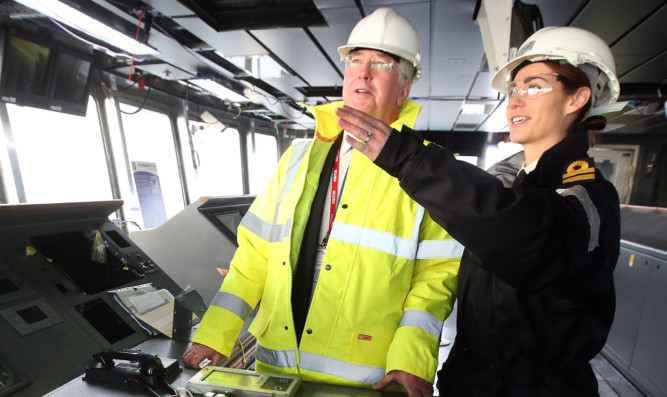Defence Secretary Michael Fallon has inspected progress on the largest warship ever-built in the UK as engineers work to get it ready for sea trials in a year’s time.
The 65,000-tonne aircraft carrier HMS Queen Elizabeth is under construction at Rosyth and is expected to set sail for the south of England in the spring of 2017.
A second carrier in the class, HMS Prince of Wales – which is not so far on in the construction process – is also being put together at the Fife base by the Aircraft Carrier Alliance (ACA).
Mr Fallon declared he was happy with the progress being made.
Speaking following a tour of HMS Queen Elizabeth, he said: “I’m very pleased to see Queen Elizabeth really taking shape now and getting ready for her sea trials, which I hope will be towards the end of next year, before she sails down to Portsmouth for final fitting-out and then over to the United States to collect the jets that will fly off her.
“After that, she’ll be ready to go out anywhere to sail the seven seas to defend us against our enemies.”
Those behind the project, which costs an estimated £6.2 billion overall, say the QE Class will be the centrepiece of Britain’s naval capability.
Each carrier will provide the armed forces with a four-acre military operating base which can travel up to 500 miles every day to be deployed anywhere around the world.
They will be able to deploy up to 40 aircraft, including Apache and Chinook helicopters.
Mr Fallon said the carriers will “help to keep us all safer”.
He toured the carrier as the ship’s gas turbines were fully up and running for the first time.
The turbines are among the most powerful in the world and will provide the ship with enough energy to light up a town the size of Dundee and to take the giant ship up to its top speed while at sea.
His visit followed last month’s announcement of the UK Government’s National Security Strategy and Strategic Defence and Security Review.
In it, the UK Government confirmed it is to reduce the number of frigates to be built on the Clyde from 13 to eight. The Prime Minister said eight Type 26 global combat ships will start to replace their Type 23 predecessors.
David Cameron also revealed a new fleet of nine maritime patrol aircraft will be based in Scotland.
The Ministry of Defence (MoD) said on Monday that, over the next decade, it plans to spend about £8 billion on conventional warships for the Royal Navy, all of which will be built in Scotland.
Mr Fallon said: “In Scotland we’ve spent some £5 billion overall building these two carriers.
“There’s potentially another £8 billion worth of naval shipbuilding work now available through the new Type 26 frigates that we need to be built, the new offshore patrol vessels and a new lighter frigate we want to develop and add to that fleet.
“There’s no reason why almost all of that work shouldn’t be done in Scotland.”
Archie Bethel, chief executive of Babcock Marine & Technology, said: “The build of HMS Prince of Wales and commissioning of HMS Queen Elizabeth is progressing rapidly here in Rosyth and I know that the teams lucky enough to be working on this historic project are very proud of the progress made so far.
“We are now looking forward to seeing HMS Prince of Wales becoming structurally complete next year and HMS Queen Elizabeth setting off for sea trials shortly after.”
